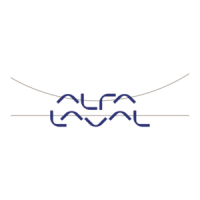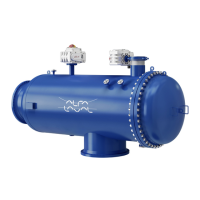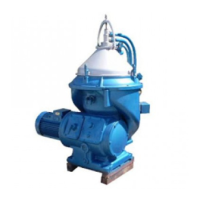
Do you have a question about the Alfa Laval AFPX 517XGV-14CG and is the answer not in the manual?
| Brand | Alfa Laval |
|---|---|
| Model | AFPX 517XGV-14CG |
| Category | Water Filtration Systems |
| Language | English |
Explains the fundamental concepts of separation, including gravity and centrifugal methods.
Explains how centrifugal force in a rotating bowl achieves rapid separation of components.
Details the mechanical components and operation of the separator's internal systems.
Explains how the separator achieves the separation of different liquid phases and solids.
Describes the mechanism responsible for ejecting accumulated sediment from the bowl.
Identifies key parameters that affect the efficiency and outcome of the separation process.
Describes methods for cleaning the separator bowl without complete dismantling.
Guides the user through the standard procedures for operating the separator.
Details essential checks and preparation steps required before initial operation.
Explains how to select the correct gravity disc for optimal separation based on process needs.
Lists the final checks and conditions required before starting the separator.
Provides step-by-step instructions for safely starting the separator and monitoring its operation.
Details the procedures for normal operation, including feed adjustment and pressure checks.
Outlines the correct steps for safely shutting down the separator during normal operation.
Explains how to perform an emergency stop and the associated safety precautions.
Covers routine maintenance tasks to prevent breakdowns and ensure reliable operation.
Details the step-by-step process for carrying out Intermediate and Major Services.
Lists critical inspection points and checks to be performed during IS.
Details how to inspect for and identify corrosion damage on separator parts.
Describes how to check for erosion damage and replace wear liners.
Guidance on inspecting for and identifying cracks in critical components.
Procedures for inspecting the lock ring joint for seizure damage and wear.
Identifies all points requiring lubrication and the recommended methods.
Procedure for verifying sufficient pressure within the disc stack for balance.
Provides detailed guidance on safely lifting the separator and its components.
Covers external cleaning of the separator and motor, including recommended methods.
Details the procedures and checks required when changing the lubricating oil.
Guidance on checking the wear on the worm wheel and worm teeth during oil changes.
Step-by-step instructions for draining and refilling the gear housing oil.
Explains how to monitor and analyze vibration levels for operational health.
General recommendations and practices applicable to various maintenance tasks.
General guidelines and recommendations for safely dismantling and assembling the separator.
Covers the disassembly, checking, and reassembly of the separator bowl.
Step-by-step guide for safely disassembling the separator bowl components.
Detailed instructions for correctly reassembling the separator bowl.
Covers the disassembly, checking, and assembly of the vertical drive system.
Covers the disassembly, checking, and assembly of the horizontal drive system.
Addresses common problems related to mechanical operation and their corrective actions.
Diagnosing and rectifying excessive vibrations in the separator.
Addresses common problems related to the separation process and their corrective actions.
Troubleshooting guide for poor separation performance.
Diagnosing why the bowl is not opening correctly for sediment discharge.
Provides key performance specifications, capacities, and operating limits for the separator.
Details all connections, their descriptions, and required operating parameters/limits.
Specifies the required quality parameters for the operating liquid to ensure performance.
Provides a comprehensive guide to lubricants, their types, and application points.
Provides guidelines for storing, transporting, and installing the separator.











